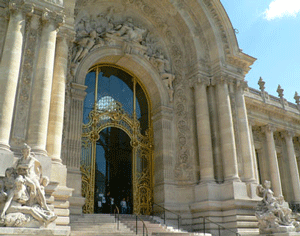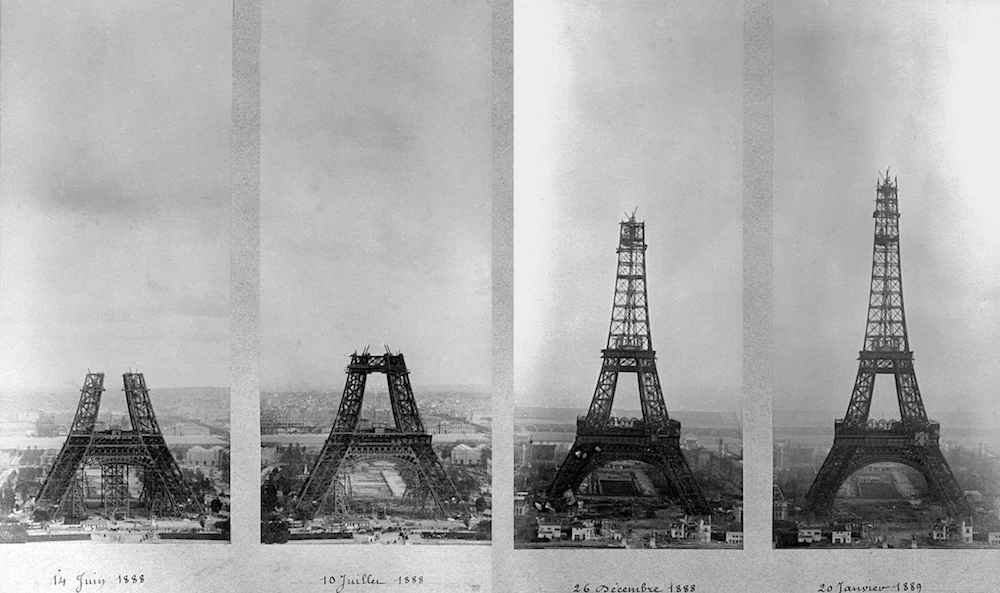THE WALK
The Universal Exposition of 1900, fifth one hosted by Paris (after those of 1855, 1867, 1878 and 1889) is considered as one of the most important in the history of this popular and commercial event.
Welcoming 51 millions visitors (while Paris has … 41 millions inhabitants !) over 200 days, the 1900 world’s fair has left few monuments and buildings still visible we invite you to discover through this walk . You will also see while strolling buildings of the 1937, 1889 and 1878 expositions.
ROUTE
- Start of the walk Metro Champs Elysees Clemenceau. Note that the Paris metro was built for the Universal Exhibition of 1900, and opened on July 19th, three months late behind the official opening. Fulgence Bienvenue headed these prodigious works, whose tomb is in the cemetery of Père-Lachaise.
- Start by walking around the « Petit Palais » nowadays Museum of Fine Arts of Paris. If you wish, enter this museum (free) to admire its architecture, particulary its romantic garden or the elegant ironwork of the main door and staircase.

- Arrived at the level of the Seine, go to the Pont Alexandre III, also built for the 1900 exhibition. The foundation stone of the bridge was laid by Tsar Alexander II of Russia (1896) symbolizing the Franco-Russian alliance signed a few years ago. You can admire, in addition to a wonderful panorama, many sculptures, including the « Lions » made by Jules Dalou (Invalides side).
![By Photoglob AG, Zürich, Switzerland or Detroit Publishing Company, Detroit, Michigan [Public domain or Public domain], via Wikimedia Commons](https://upload.wikimedia.org/wikipedia/commons/thumb/4/4b/Alexandre_III%2C_bridge%2C_Exposition_Universal%2C_1900%2C_Paris%2C_France.jpg/256px-Alexandre_III%2C_bridge%2C_Exposition_Universal%2C_1900%2C_Paris%2C_France.jpg)
Le Pont Alexandre III in 1900
- In front of the Petit Palais is the Grand Palais, houses today major exhibitions and events. A soon as the order of these two “Palais”, it was decided that they would not be destroyed after the exhhibition, unlike and unfortunately!) most of the buildings.
- Behind the Grand Palais (Avenue Franklin D. Roosevelt) is the Palais de la Découverte, a superb museum dedicated to sciences.
- Take the Cours Albert 1er (towards the Eiffel Tower).
Photo credit: albir / Foter.com / CC BY-NC-SA
- You will discover on this beautiful walk along the Seine nice public masterpieces including the Monument to Adam Mickiewicz made by Antoine Bourdelle(this work has nothing to do with Universal expositions, but interesting to see !)
- Place de Alma, continue straight on avenue de New York. You will pass by the Palais de Tokyo, double building built for the Universal Exhibition of 1937. Today Museum of Modern Art of the City of Paris and Site of Contemporary Creation, this place was from its construction to become a cultural center in Paris.
- Especially note the nice Art Deco bas-relief of the building, designed by Pierre Janniot.
- Cross the Palais de Tokyo and take Avenue President Wilson towards Place d’Iena. On the corner in front of you is a large building, the Palais d’Iéna, also built for the 1937 exhibition. It is now the Economic, Social and Environmental Council, a French Consultative Assembly.
- Continue straight ahead. You arrive on the beautiful Place du Trocadero, esplanade especially known for its breathtaking views of the Eiffel Tower.
- Again, the buildings you see (Palais de Chaillot) were built in 1937. For the 1878 exhibition, a magnificent Moorish and neo-Byzantine palace was at this place, but will be destroyed after the exhibition of 1900.
- Cross the Trocadero gardens and go to the Eiffel Tower, built for the exhibition of 1889. While originally the palace of the Trocadero was predestined to remain and the Eiffel Tower to be taken off, it is just the opposite that happened!
- The walk ends at the Champ de Mars. It is here that took place all the expositions (except in 1855).
View from Montparnasse Tower

